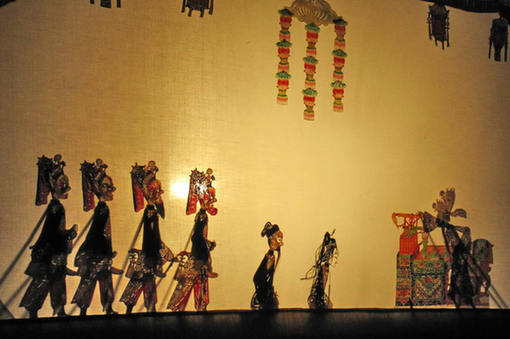Wei Jinquan, Casting Light on Shadow Plays
Born into a family of Shadow Play performers, Wei Jinquan has made and performed with shadow puppets since boyhood. His works, which features quality craftsmanship and traditional techniques, are now sold around the world. He has performed many times, both inside and outside China, including three events in France. Wei was named an inheritor of China’s intangible cultural heritage in 2008.
By staff reporter JIAO FENG
On April 8, 2014 a man in Huaxian County, Weinan City, Shaanxi Province held a wedding for his son. Following local traditions, in the evening he sponsored a performance of Shadow Play to entertain his neighbors.
The stage was set up, but it was not until nearly 8 pm, when the sky was completely dark, that the cast headed by Wei Jinquan took their seats in the tent behind the white curtain. The light went on, music played, and the audience, carrying their own stools and some with babies in arms, streamed in. As the beats of drums and gongs intensified, the spectators were engrossed. Some passers-by stopped over and watched, exclaiming: “It has been years since I last saw this.”
Shadow Play is a traditional folk art in Huaxian, dating back 2,000 or more years. But like all other cultural heritage, it has declined to the verge of extinction. The number of performers in the county has plummeted to below 20, and 50-year-old Wei Jinquan is the youngest of them.
 |
|
Weinan shadow puppets are carved out of cattle hide, and jointed at the neck, shoulders, waist and knees. |
The Origin of Shadow Play
In an interview with China Today, Wei said more than once: “We have to get more young people to learn Shadow Play so that it won’t vanish in the future.”
Shadow Play, also known as Light Shadow in some regions, is an ancient performance art in China. Players use engraved leather figures to cast shadows on the screen, and accompany the movement with singing and music. Shadow Play is believed to originate in the ancient capital Chang’an (today’s Xi’an) 2,000 years ago. Huaxian, 90 km from Xi’an, is its birthplace. Along with military expeditions and trade exchanges over land and sea, Shadow Play found its way to Europe, Persia, Arabia, and other Asian countries.
The puppets used in Huaxian Shadow Play are carved out of cattle hide. Each measures more than 0.3 meters in height, and the style is in some sense expressionist, as evident in the surreal figures, brilliant colors and elaborate carvings. These two dimensional marionettes are articulated and string-pulled with wires attached to 10 joints at the neck, shoulder, waist, knees, and elbows. The figure can make deft movements at the hand of its manipulator.
Huaxian Shadow Play is locally called “the busy five,” as the typical cast includes five members. One plays the vocal part for all characters as well as drum and Yueqin, a five-stringed plucked musical instrument. One operates the puppets and sings. The third juggles between five percussions. And the fourth and fifth each play two more stringed or wind instruments.
